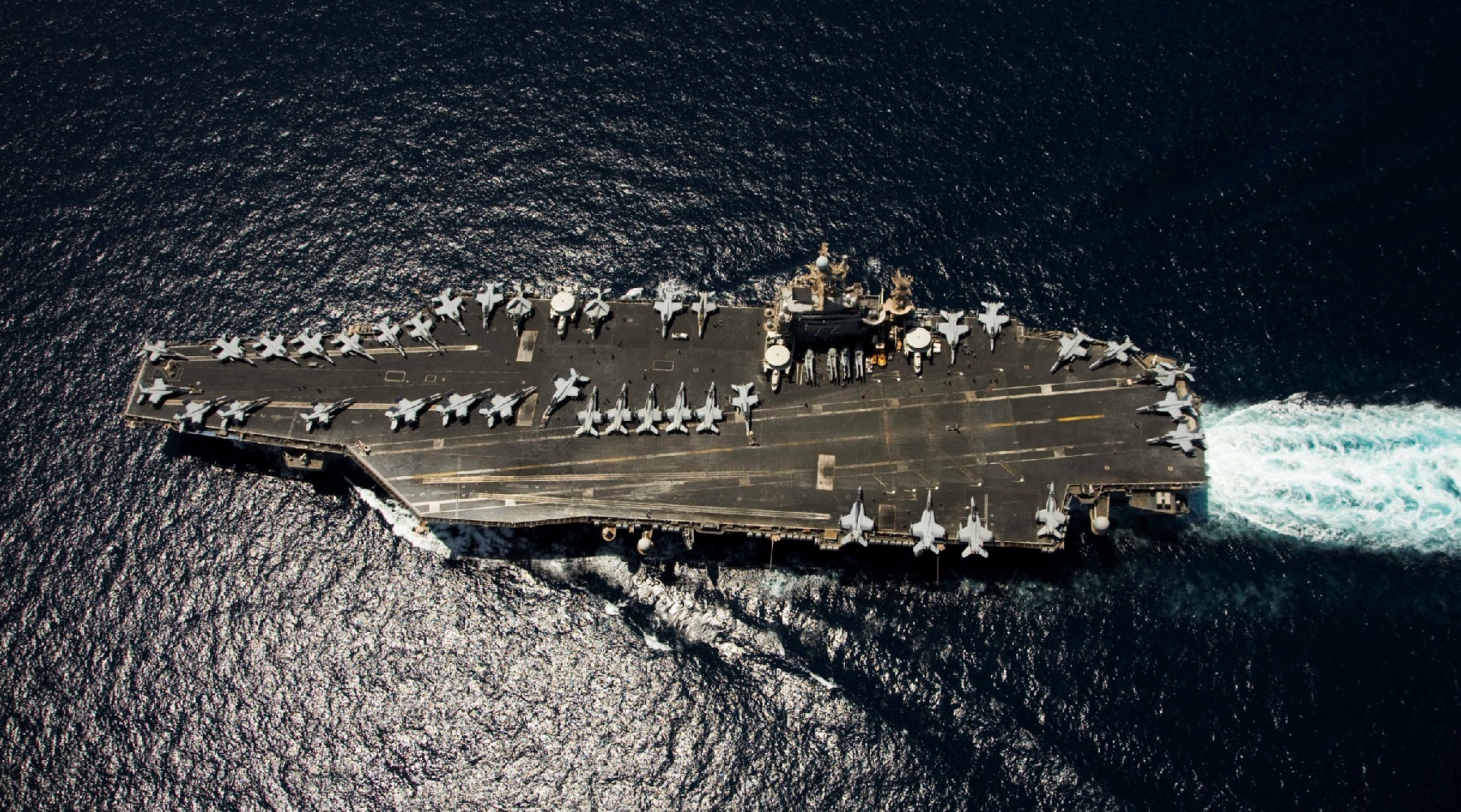Ramped Aircraft Carrier - STOBAR ("Short flight but return to capture" or "short flight, obstacle recovery") is a system used to launch and rescue aircraft from aircraft carriers. It combines the elements of "Short Flight and Vertical Landing" (STOVL) and "Flight Out of Baggage but Capture" (CATOBAR).
Launching an aircraft under autonomous power using ski jumps to aid flight. However, this aircraft is a normal aircraft rather than a STOVL and therefore requires a landing on board. STOBAR system is easier to build than CATOBAR by 2018.
Ramped Aircraft Carrier

Compared to CATOBAR, STOBAR is less complicated to develop. It is easier to use than the CATOBAR configuration, which requires a large number of operators to start the aircraft. The lack of moving parts in the ski jump makes maintenance of the launch system more difficult.
Us Navy Aircraft Carrier Uss Reagan Enters South China Sea
No additional system required. To generate the force needed to shoot the plane. Unlike CATOBAR, external force is required to generate from the steam catapult.
An important limitation of the STOBAR configuration is that it only works with high-strength fighter jets such as the Su-33 or MiG-29K, thus determining the type of aircraft that can be operated by the carrier. Unknown
Does skiing restriction mean maximum take-off weight? According to some sources, in order to be able to fly on aircraft, aircraft may need to limit their weapons and fuel storage to reduce the weight of their launches.
The Super Hornet can fly off a ski jump with a variety of weapons. The use of ski jumps can limit the ability to sort faster on STOBAR aircraft carriers.
Russia Delays Delivery Of Ins Vikramaditya By A Year
The STOBAR aircraft carrier must maintain speed. 20-30 kN (37-56 km / h) to generate the necessary wind speed on board. Required for aircraft launch operations
As of January 2023, there are three countries operating STOBAR carriers. Russia and China are the only countries that build operational STOBAR ships. While both India and China bought Russian-made STOBARs and modified them for their own use. India is in the process of deploying its first aircraft carrier. Currently undergoing extensive sea tests, the Royal Navy Sea Harrier set sail from HMS Invincible in May 1990.
In flight, ski jumping is a curvature that allows the aircraft to take off from the runway shorter than the aircraft's flight level, forcing the aircraft to take off. . While allowing the aircraft to accelerate more in the air than on the runway. Ski jumps are often used to fly aircraft from unmanned aircraft carriers.
It is believed that the first use of skis occurred during World War II. A temporary ramp was added to HMS Furious to assist in the flight of Fairey Barracudas heavy aircraft to attack the German warship Tirpitz during the Cold War. The concept is being studied to reduce the flight time required for future aircraft carriers. As well as to carry heavier aircraft at sea, the Royal Navy was particularly interested in skiing in the 1970s, conducting a series of experiments with the Hawker Siddeley Harrier VSTOL, which developed the new fighter jet. Before choosing to incorporate this feature into their next aircraft carrier, the Invincible class.
Year Of Unusually High Us Activity Noted In South China Sea
Many navies have demonstrated their value in action. It has adopted ski jumping for its aircraft carriers and amphibious offensive platforms. While grounded as well, Ski-jump can be used in two different ways: Short Take-Off But Arrested Recovery (STOBAR) and Short Take-Off, Vertical Landing aircraft (STOVL); These involve the operation of convtional and VSTOL aircraft, respectively. Catapult-equipped aircraft carriers have become a minority in the top 21 due to the reduced cost and complexity of skiing operations.
HTMS Chakri Naruebet is a small Thai ship made in Spain. With skiing in the South China Sea in April 2001
A plane with fixed wings must generate forward speed during flight. As the forward speed increases, the wings will produce more lift. At high speeds, the lifting force exceeds the weight of the aircraft. And the aircraft will be able to continue flying. This is because the aircraft has to fly at speed using only its own generator. Therefore, a longer runway is needed to allow the aircraft to accelerate. On aircraft carriers, the flight speed is so short that most aircraft can not reach the flight speed before reaching the d of the ship because the lift is less than gravity. The plane will lose height after the landing gear is off the runway and may fall into the sea.
The ski runner d of the runway turns the direction of the aircraft up slightly. Convert part of the forward movement of the aircraft to a positive rate of ascent. Because the plane was still traveling at a speed not enough to cause a lift. Thus, the rate of climbing begins to decrease as soon as it leaves the jacket.
Fact: America Considered Turning Its Battleships Into Aircraft Carriers
At that point, the speed is reduced to zero. The aircraft will travel so fast that its wings cannot be lifted at this time. Launched from the airline without ever falling below the height of the aircraft.
Many modern aircraft carriers lack launchers. Therefore, heavy aircraft must fly using their own gins. Ski jumps allow heavier aircraft to fly more than horizontal jumps. However, ski jumping cannot be compared to the load achieved by high-speed catapult firing.
While aircraft such as the F / A 18, which are typically catapulted, can use ski slopes. But it generally reduces the capacity for fuel or bombs. And severely affect the scope of the mission

The Fairey Barracuda took off from a makeshift skier on HMS Furious in 1944, clearly visible on the skis.
Us Moves Carrier Strike Group Out Of Gulf As Tensions With Iran Appear To Ebb
Early aircraft carriers could fly a plane simply by turning it into the air and increasing the speed of the ship to the wind speed experienced by the aircraft. During World War II, heavy passenger planes needed flight assistance. Ship launchers are used to accelerate aircraft for flight. Especially when flying a heavy plane or when not wanting to change course.
The earliest use of ski jumps occurred in 1944 when the British aircraft carrier HMS Furious attacked the German warship Tirpitz. Fairey Barracudas Heavy bomber took off.
In the years following World War II, the growing popularity of heavy aircraft continued to accelerate. This leads to fears that such an increase will exceed the storage capacity of the catapult system. As a result, alternative methods of flight assistance are being explored. NACA study completed. In 1952, it was proposed to use skis behind the catapult to provide additional assistance to departing aircraft.
In 1973, M.Phil thesis Master Taylor of the British Royal Navy proposed using skis to help the Harriers board.
Royal Navy Aircraft Carrier Ski Jumps
His skydive design, with its initial curves, is full of skepticism. But other officials. Ignore such offers.
Therefore, preliminary testing using different slope angles was performed at RAE Bedford; The aircraft used was a two-seater G-VTOL demonstration aircraft.
These tests show that performance increases with bounce angle. But planners choose the lowest angle. Allegedly, the reason behind this option is to avoid putting too much pressure on the underside of the aircraft.

In the 1970s, the Navy was considering building aircraft carriers or light aircraft carriers. And decided to incorporate ski jumping into the project
Medium Aircraft Carriers: The Big Idea The Us Navy Hates
For this reason, Invincible aircraft carriers were built with ski jumps. It reduces the distance needed for the Harrier to fly out even when carrying a useful load.
Skipping has proven to be an inexpensive and convenient accessory for operators. With a steel structure without moving parts, a skid was added to the first aircraft carrier of the HMS Invincible while she was being fitted in the Barrow; It is set at a conservative 7º angle. On October 30, 1980, a test pilot, Lt. David Poole skied for the first time to help the Harrier get into the sea.
HMS Illustrated is also equipped with a 7º ramp. However, HMS Ark Royal was originally built with a 12º slope. Which is defined as the most appropriate angle. The previous two ships were later upgraded with a 12º slope to increase aircraft capacity.
Following the success of the Harrier, ski jumping became a proven method for unplanned flying from a ship and using a catapult. More than that. Skiing later, it is determined that there is little groove or
U.s. Send Aircraft Carrier, Bombers As 'clear Message' To Iran
Aircraft carrier, army aircraft carrier, aircraft carrier lego, charleston aircraft carrier, aircraft carrier san diego, aircraft carrier museum ships, lexington aircraft carrier, micro machines aircraft carrier, aircraft carrier lego set, aircraft pet carrier, midway aircraft carrier, lego navy aircraft carrier
0 Comments